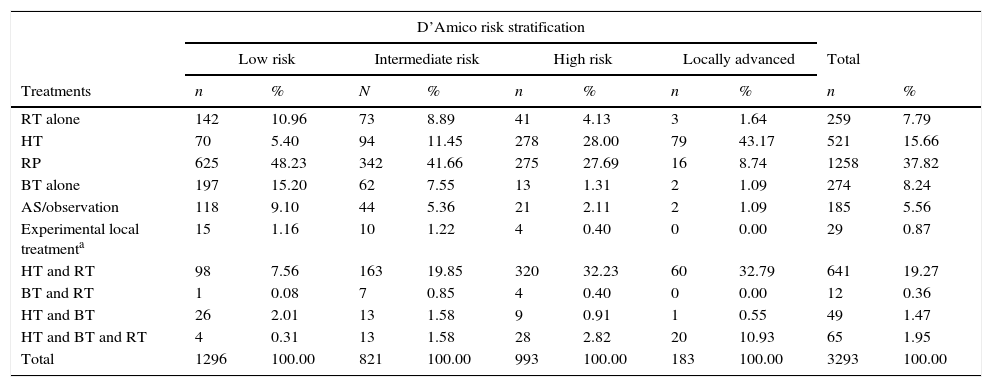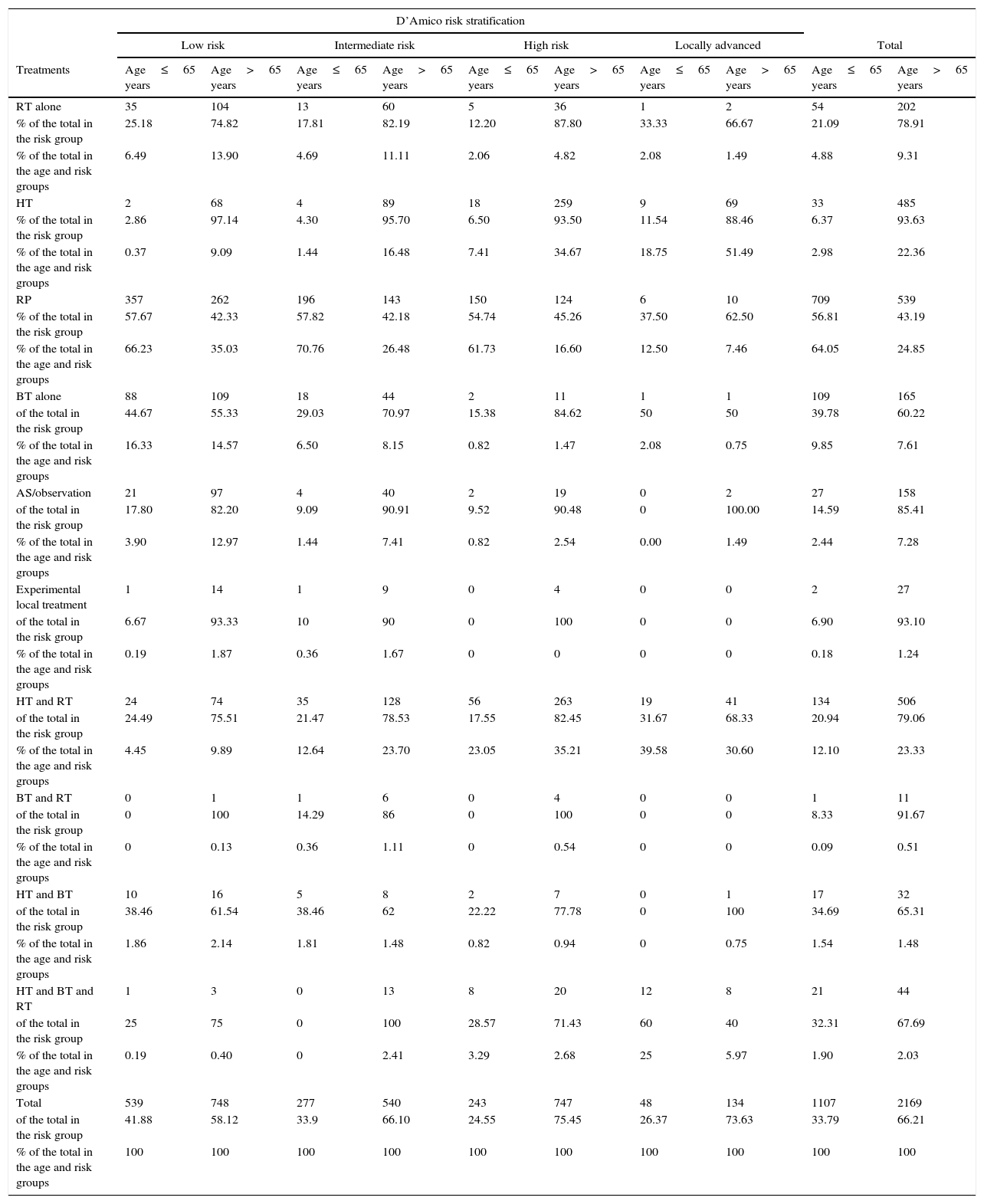To describe the established therapies for localized prostate cancer (PC) in Spain and to assess compliance with the 2010 UAE guidelines.
Patients and methodsThis was an epidemiological, observational, prospective and multicentre study. Of the 3918 patients diagnosed with PC during 2010, only those patients with localized PC were included. Follow-up was ultimately conducted for a minimum of one year from the diagnosis for 3713 patients (94.77%). The treatment groups assessed were as follows: radical prostatectomy, radiation therapy, hormone therapy, brachytherapy, active surveillance or observation and experimental local treatment (cryotherapy or other treatment). Compliance with the recommendations of the EAU guidelines was studied, describing the treatment groups according to D’Amico risk stratification criteria (localized [low, intermediate and high risk] and locally advanced), age, PSA and Gleason score.
ResultsBy applying the D’Amico criteria, we included 3641 (92.93%) patients. Based on the UAE recommendations: (1) 68.87% of the patients at low-intermediate risk aged ≤65 years underwent radical prostatectomy; (2) 34.51% of the patients >65 years at high risk with locally advanced disease were administered radiation therapy and hormone therapy; (3) 30.36% of the patients at high risk with locally advanced disease were only treated with hormone therapy; (4) 15.20% of the patients at low risk were only treated with brachytherapy; (5) active surveillance or observation was selected for 2.44% of the patients aged ≤65 years and for 10.63% of the patients at low-intermediate risk who were >65 years. Lastly, 86.5% of the patients at low risk underwent a single treatment, and 43.62% of the patients at high risk with locally advanced disease underwent combined treatments.
ConclusionsThis is the first national European study to evaluate the therapeutic management of localized PC based on the risk group to which the patient belonged. Most young patients (≤65 years) with low-intermediate risk localized PC were treated with surgery, which adheres to the recommendations of the 2010 UAE guidelines. Various therapeutic combinations have been employed for patients with high-risk, locally advanced localized tumors, revealing the need for a multidisciplinary approach (Controlled-trials.com number: ISRCTN19893319).
Describir las terapias establecidas para el cáncer de próstata (CaP) localizado en España y valorar el cumplimiento de las guías EAU 2010.
Pacientes y métodosEstudio epidemiológico, observacional, prospectivo y multicéntrico. De los 3.918 pacientes diagnosticados con CaP durante 2010, solo se incluyeron los pacientes con CaP localizado. Finalmente, se hizo el seguimiento durante un periodo mínimo de un año a partir del diagnóstico a 3.713 pacientes (94,77%). Los grupos de tratamiento evaluados fueron: prostatectomía radical, radioterapia, terapia hormonal, braquiterapia, vigilancia activa u observación y tratamiento local experimental (crioterapia u otro tratamiento). Se estudió el cumplimiento de las recomendaciones de las guías EAU describiendo los grupos de tratamiento según los criterios de estratificación de riesgo de D’Amico (localizado [bajo riesgo, riesgo intermedio y alto riesgo] y localmente avanzado), edad, PSA y puntuación Gleason.
ResultadosConsiderando los criterios D’Amico, se incluyó a 3.641 (92,93%) pacientes. Según las recomendaciones EAU: 1) se hizo prostatectomía radical al 68,87% de los pacientes de riesgo bajo-intermedio de≤65 años; 2) se administró radioterapia y terapia hormonal al 34,51% de los pacientes con riesgo alto-enfermedad localmente avanzada>65 años; 3) se trató solo con terapia hormonal al 30,36% de los pacientes con riesgo alto-enfermedad localmente avanzada; 4) recibieron solo braquiterapia el 15,20% de los pacientes con riesgo bajo; 5) se eligió la vigilancia activa u observación en el 2,44% de los pacientes≤65 años y en el 10,63% de los pacientes de riesgo bajo-intermedio>65 años. Por último, el 86,5% de los pacientes de bajo riesgo recibió un único tratamiento y el 43,62% de los pacientes con riesgo alto-enfermedad localmente avanzada recibió tratamientos combinados.
ConclusionesEste es el primer estudio europeo de ámbito nacional que evalúa el manejo terapéutico para el CaP localizado en función del grupo de riesgo al que pertenece el paciente. La mayor parte de los pacientes jóvenes (≤65 años) con CaP localizado de riesgo bajo e intermedio fueron tratados con cirugía, lo cual se adapta a las recomendaciones de las guías de la EAU de 2010. En los pacientes con tumores localizados de alto riesgo y localmente avanzados se han empleado distintas combinaciones terapéuticas, poniendo de manifiesto la necesidad de un abordaje multidisciplinar (número de Controlled-trials.com ISRCTN19893319).








